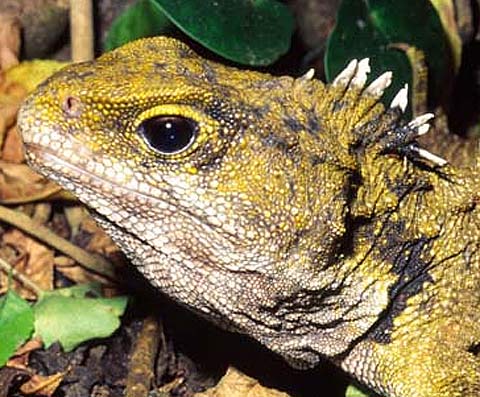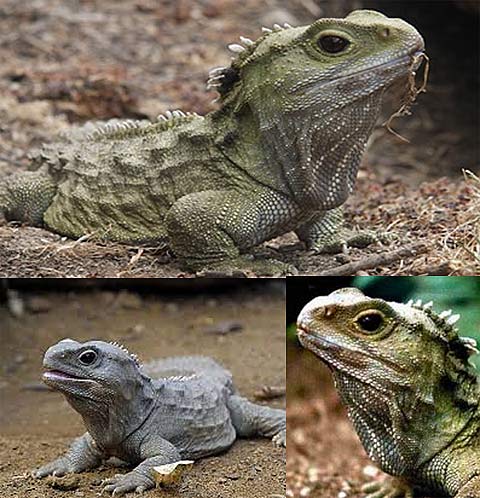Tuatara – The Lizard that Isn’t

Tuataras are relics of a bygone age now found only in isolated parts of New Zealand. Males grow up to 24in (61cm) from snout to tip of tail and weigh 2.2lb (1kg) while females grow up to 18in (45cm) and weigh 1.1lb (0.5 kg). Their name comes from a Maori word meaning “peaks on the back,” a reference to the triangular folds of skin that form a conspicuous crest along the back and tail of the male, and a rudimentary crest on the female. The crest is normally soft and pliant, but can be raised and stiffened in a threat display by the male when alarmed. Females are very timid, retreating hastily when disturbed.
Among their many curious features these reptiles possess, are a third “eye” in the top of the head, eggs that take 15 months to hatch and a lifespan in excess of a century. It is the sole surviving member of an entire reptilian order, the Rhynchocephalia, which came into being in the Mesozoic (220 million years ago), before the first dinosaurs appeared. Rhynchocephalians lived in Europe, Asia, North and South America, and southern and East Africa, but all except the tuatara were extinct by the end of the Mesozoic (65 million years ago). It is almost identical in structure to a form that existed about 140 million years ago, which makes it of exceptional interest to scientists, who study it for clues to the physiology and anatomy of reptiles that lived over 200 million years ago.

Although it superficially resembles a lizard, the tuatara has a number of features which clearly distinguish it: the structure of the skull, which has two pairs of arches like a crocodilian’s; the vertebrae, which are hollow at each end; a small projection on the back of each rib (the uncinate process); a bony skeleton in the abdominal wall; the jaw teeth, which are not separate structures but serrations of the jaw bone; the absence of an ear drum (tympanum) and of a middle ear, and the absence of a male copulatory organ. Some features of the tuatara’s brain and of its locomotion resemble conditions in amphibians, and its heart is more primitive than that found in any other reptile group.
Some of the tuatara’s specialized features appear to be associated with a change habitat since the days of its early ancestors. This reptile is now a nocturnal burrower with specializations of the visual cells, including a “duplex retina” containing two types of visual cell, which presumably enable the animal, like crocodiles and turtles, to see by night as well as by day. The retina is backed by a tapetum lucidum, a lave: which reflects light back through the sense cells a second time. Tuataras have a low metabolic rate, a capacity for low temperature activity and long, slow growth. Like a lizard’s, the pineal body in the tuatara’s brain is connected to a “third eye” on the top of the head: the narietal a structure fnund below the skin in a space between the parietal bones in the roof of the skull. The parietal has many of the structural features of an eye, including a lens, retina and nervous connections to the brain, but experimental work has shown that, although sensitive to light, it cannot contribute to the formation of visual images. The pineal body in the tuatara is not known to be sensitive to light, but it also has a structure which would permit light sensitivity.
The islands where the tuatara survives today are all wholly or partially cliff-bound, with boulder beaches, and the seas surrounding them can change rapidly. Landing on the islands is difficult, helping to protect them from interference by man. On islands that are more readily accessible, the tuatara has been eliminated through disturbance of habitat and introduction of predators. Large populations of burrowing seabirds (for example, petrels, prions, and shearwaters) come ashore each year to nest. By their burrowing they provide shelter for the tuataras (although they can dig their own burrows) and by defecation and shuffling movements on the forest floor they encourage a high concentration of ground insects, especially beetles, which provide a large part of the tuatara’s diet. The diet also includes spiders, earthworms, slaters, slugs, snails, geckos and skinks and the chicks and eggs of seabirds. Adults occasionally eat young tuataras.

Apart from coming out of their burrows on sunny days to bask in or near their burrow entrances, tuataras are active at night. They mate in January (Southern Hemisphere summer), and in October or November (spring) the females excavate burrows 4in (10cm) deep or more, in which they lay 6-15 eggs. The eggs are bluntly oval, about 1-1.2in (25-30mm) long, and enclosed in a parchment-like covering. The incubation period is approximately 15 months – the longest known for any reptile. During incubation the eggs are vulnerable to predators, and to damage from extreme changes in climatic conditions. The embryo develops a horny, bluntly thorn-shaped egg-breaker on the top of its nose. With this it slits the soft shell before emerging. The hatchlings are about 2.2in (54mm) long from snout to vent, and are very active – a necessary feature for survival, as they are almost immediately dependent on their own efforts to find food. They may dig small burrows for themselves, or hide under stones or logs. The egg-breaker disappears about two weeks after hatching. Growth is long and slow; tuataras reach sexual maturity at about 20 years of age, and growth continues until 50-60 years of age. It is likely that they may live for over 120 years; but this has yet to be proven, and views that tuataras live to be 200-300 years of age are sheer speculation.
Their survival in New Zealand, while its relatives became extinct in all other parts of the world, is probably due to the fact that New Zealand became separated from other land masses about 80 million years ago, before any of the later evolving land predators reached it. Apart from man, their main enemy may now be the kiore, or Polynesian rat (Rattus exulans); the best self-maintaining populations occur on rat-free islands. The tuatara is absolutely protected by the New Zealand Wildlife Act -protection essential for its survival.
